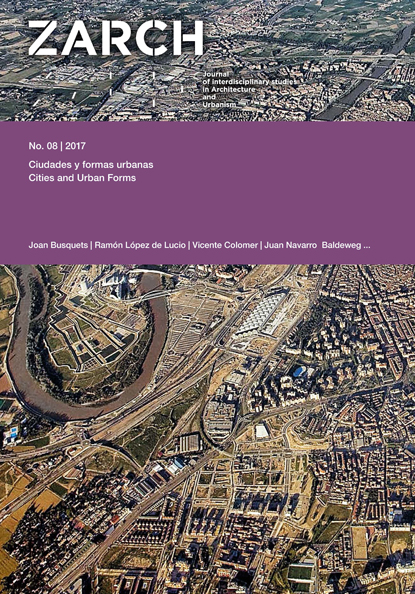El proyecto religioso del cardenal Montini a la vanguardia de la arquitectura milanesa. El caso de Mater Misericordiae, icono de la modernidad
DOI:
https://doi.org/10.26754/ojs_zarch/zarch.201782168Palabras clave:
Milán de posguera, Arquitectura sacra, Renovación litúrgica, Iglesia y modernidadResumen
Durante la década de los años cincuenta del pasado siglo la ciudad de Milán creció a un ritmo acelerado al tratar de acomodar a la población que, como consecuencia de los movimientos migratorios acaecidos al final de la Segunda Guerra Mundial, se había ido alojando en la periferia. Algunas entidades, como la Diócesis de esta ciudad, trataron de dar ayuda espiritual a los habitantes de estas áreas en crecimiento, consolidándose esta iniciativa en un plan de construcción de nuevos complejos parroquiales en los alrededores de la ciudad. En el año 1955 es nombrado Arzobispo de Milán Giovanni Battista Montini, futuro Papa Pablo VI, que será una figura clave, el verdadero artífice tanto de este plan de construcción de iglesias como de la modernización de la imagen de la arquitectura sacra en Milán. Montini encargó muchos de los proyectos a arquitectos innovadores de experiencia probada, que trabajaban habitualmente en Milán o en otras zonas de Italia, pero también solicitó la redacción de algunos proyectos a jóvenes arquitectos que apenas tenían experiencia en el campo de la arquitectura eclesiástica. Con él, el ritmo de construcción de iglesias se incrementó considerablemente en los alrededores de la ciudad, llegando a levantarse en esos años más de cien nuevos edificios sacros. La intención de este texto es señalar, a través de una serie de ejemplos relevantes, entre los que destaca la iglesia Mater Misericoridae, cómo la Diócesis de Milán contribuyó, mediante una renovación de la imagen de la Iglesia como institución a través de su arquitectura, a definir la identidad de algunos barrios periféricos de la ciudad. En ellos, las nuevas construcciones eclesiásticas se convirtieron en hitos, símbolos de una importante renovación litúrgica que se había iniciado unas décadas antes en otros puntos de Europa Algunas de las nuevas propuestas arquitectónicas, en las que la Iglesia Católica apostó por apoyar la reconciliación entre arte moderno y arte sacro, se convirtieron en modelos de referencia en los que confluían tradición y modernidad. El caso concreto de la Iglesia Mater Misericordiae permite reconocer un alto grado de experimentación, muy por encima de otras arquitecturas coetáneas, tanto religiosas como civiles, muestra de la apuesta que la Diócesis milanesa, y en concreto el Cardenal Montini, hizo al apoyar la construcción de un proyecto renovador de verdadero carácter vanguardista.
Descargas
Referencias
Barazzetta, Giulio, 2015. La Chiesa di vetro a Baranzate: la costruzione e il restauro della Chiesa Mater Misericordiae di Angelo Mangiarotti, Bruno Morassutti, Aldo Favini. Milano: Electa architettura.
Barazzetta, Giulio. 2011. “Progetto e cantiere, idea e costruzione” en Costruttori di modernità.Assimpredil Ance 1945-2011, coord. Raffaella Poletti. Milano: Assimpredil.
Bernabei, Giancarlo, Giuliano gresleri. 1983. Le Riviste. En Parole e Linguaggio dell’Architettura Religiosa 1963-1983. Veinte anni di realizzazioni in Italia, coord. Giuliano Gresleri. Firenze: Faenza Editrice.
Biagi, Paola di, Celia Marín. 2010. El plan INA-Casa, 1949-1963: barrios y ciudad en la Italia de los años 50. Visiones. 8 (noviembre).
Bielza de Ory, Vicente. 1977. El sistema urbano italiano. Geographicalia.
Borsotti, Marco. 2015. Chiese e modernità. Itinerari di Architettura Milanese. L’architettura moderna come descrizione della città, Milán: Solferino edizioni.
Bottoni, P. 1954. Il quartiere sperimentale della Triennale di Milano Q.T.8. Quaderni Triennale 06.
Caballero, Beatriz. 2014. 1963: La exposición, nuevas iglesias en Alemania, la nueva arquitectura sacra en Alemania y las iglesias del Instituto Nacional de Colonización en España. Ponencia presentada al Congreso. “Las exposiciones de arquitectura y la arquitectura de las exposiciones”, 8 y 9 de mayo en Pamplona.
Comitato per le nuove chiese nell’arcidiocesi di Milano. “Relazione ufficiale per gli anni 1937-1953,” Rivista Diocesana Milanese (anno XLIII, 81954, fascicolo speciale).
De Carli, Cecilia. 2016. Le nuove chiese. En Montini, Arcivescovo di Milano, coords. Luca bressan y Angelo Maffeis. Brescia: Instituto Paolo VI: 2016.
Delgado Orusco, Eduardo. 1999. Arquitectura Sacra Española: de la Posguerra al Posconcilio (1939-1975). Tesis doctoral, Departamento de Composición Arquitectónica de la ETSAM.
Dezzi Bardeschi, Marco; Bucci, Federico; Dulio, Roberto. 2006. Milano architettura e paesaggio. Milano: Mancosu editore.
Díez Medina, Carmen. 2016. Libertad en el orden. Bruno Morassutti, el arte de la prefabricación. Proyecto, Progreso, Arquitectura 15.
Díez Medina, Carmen. 2011. La mirada oblicua. La arquitectura como hecho cultural. En Proyectos integrados de arquitectura, paisaje y urbanismo, coord. Monclús, J. Jaca: Universidad de Zaragoza.
Fernández Cobián, Esteban. 2011. Bolonia, Lercaro y la revista Chiesa e Quartiere. Una conversación con Glauco y Giuliano Gresleri. Boletín académico de investigación y arquitectura contemporánea 1.
Fernández Cobián, Esteban. 2010. La iglesia de Alvar Aalto en Riola di Vergato. Italia. Conversación con sus constructores Glauco y Giuliano Gresleri. Revista Universidad Nacional Autónoma de Méjico 1.
Frangi, Giuseppe. 2011. Libres y sencillas. Las iglesias según Montini. Arte cristiano 01.
Gandolfi, Vittorio, Antonello Vincenti. 1959. Sviluppo della pianificazione parrocchiale a Milano. Chiesa e Quartiere 9-10: 24.
Gherardi, Luciano. 1959. Documentazione delle dieci nueve chiese. Chiesa e Quartiere 9-10: 43-89.
Gorostiaga, Clara Inés. 2012. La iglesia y el arte moderno: tres momentos. Argentina: ESEADE.
Plazaola Artola, Juan. 1965. El arte sacro actual. Madrid: Biblioteca de autores cristianos.





